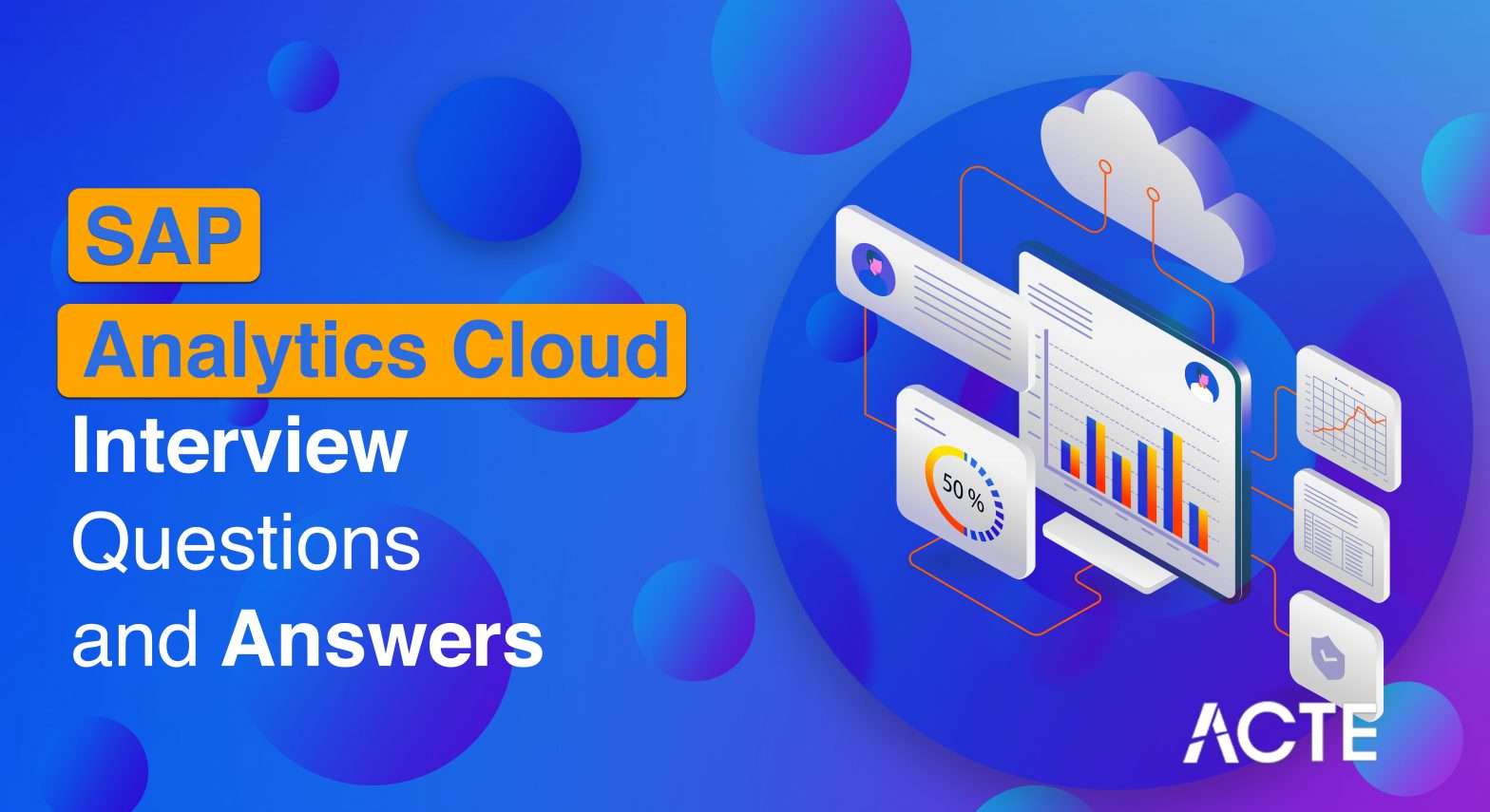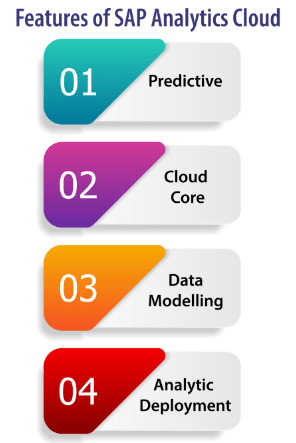
SAP Analytics Cloud is a cloud-based platform that integrates business intelligence, planning, and predictive analytics. It allows users to analyze data from various sources, create interactive dashboards, perform advanced analytics, and collaborate with team members in real-time. Its features include data visualization, augmented analytics, predictive analytics, and planning capabilities, helping organizations make data-driven decisions and drive business growth.
1. What is SAP Analytics Cloud (SAC)?
Ans:
SAP Analytics Cloud (SAC) represents a comprehensive cloud-based analytics solution that integrates a variety of functionalities, including business intelligence, planning, and predictive analytics. It serves as a unified platform for organizations to leverage their data effectively, enabling them to gain valuable insights, make informed decisions, and drive business growth. SAC stands out for its user-friendly interface, scalability, and robust features, making it a preferred choice for businesses aiming to harness the power of analytics in the cloud.
2. What are the key features of SAP Analytics Cloud?
Ans:
- SAC offers a plethora of features tailored to meet the diverse needs of organizations across industries.
- Some of its key features include advanced data visualization capabilities, collaborative planning functionalities, predictive analytics tools, and seamless integration with various data sources.
- Additionally, SAC provides robust security measures, mobile accessibility, and support for real-time analytics, making it a comprehensive solution for organizations seeking to derive actionable insights from their data.

3. How does SAC support data visualization?
Ans:
SAC empowers users to create visually appealing and interactive dashboards and reports through its advanced data visualization capabilities. Users can easily drag and drop data elements onto the canvas to generate a wide range of visualizations, including charts, graphs, maps, and tables. SAC also offers customization options such as color schemes, formatting, and interactivity features, allowing users to tailor visualizations to their specific requirements.
4. Explain the planning capabilities of SAP Analytics Cloud.
Ans:
- SAC facilitates collaborative planning and forecasting processes, empowering organizations to align their strategies and resources effectively.
- Users can leverage SAC’s intuitive planning interface to create models, set targets, and allocate resources based on business objectives.
- SAC supports scenario planning, version management, and real-time collaboration, enabling teams to simulate various scenarios, analyze the impact of different decisions, and adjust plans accordingly.
5. What is predictive analytics in SAP Analytics Cloud?
Ans:
Predictive analytics in SAC involves leveraging advanced algorithms and statistical techniques to analyze historical data and make predictions about future outcomes. By identifying patterns, trends, and correlations in the data, predictive analytics enables organizations to anticipate changes, identify opportunities, and mitigate risks effectively.
6. How does SAC handle data integration?
Ans:
SAC offers robust data integration capabilities, allowing organizations to connect to a variety of data sources seamlessly. Users can establish connections with on-premises and cloud-based systems, databases, applications, and files, enabling them to access and analyze data from disparate sources in a unified environment. SAC supports both live and import data connections, ensuring that users can work with real-time or historical data as needed.
7. Can SAC handle big data?
Ans:
Yes, SAP Analytics Cloud (SAC) is designed to manage large volumes of data, including big data sets, through its robust and scalable cloud infrastructure. By utilizing advanced cloud computing resources, SAC can efficiently process, analyze, and visualize extensive datasets without compromising performance. This scalability enables organizations to handle complex data operations seamlessly while maintaining speed and accuracy.
8. Explain the collaboration features of SAP Analytics Cloud.
Ans:
- SAC offers a variety of collaboration features designed to facilitate teamwork and communication among users.
- These features include shared workspaces, comments, annotations, and real-time collaboration capabilities.
- Users can collaborate on reports, dashboards, and planning models, share insights, provide feedback, and make decisions collaboratively within the SAC environment.
9. How does SAC ensure data security and compliance?
Ans:
- SAC prioritizes data security and compliance, implementing robust measures to protect sensitive information and ensure regulatory compliance.
- These measures include data encryption, access controls, user authentication, and audit trails, which safeguard data from unauthorized access, tampering, or disclosure.
- SAC also complies with industry standards and regulations, such as GDPR, SOC 2, and HIPAA, ensuring that organizations can trust their data to be handled securely and in accordance with legal requirements.
10. What is the crucial difference between a dashboard and a storyboard?
Ans:
| Aspect | Dashboard | Storyboard |
|---|---|---|
| Purpose | Provide real-time overview of KPIs and metrics | Tell a narrative or convey sequence of events |
| Presentation | Multiple visualizations on a single screen | Series of interconnected slides/pages |
| Interactivity | Often interactive with filters and drill-down options | Navigation may be linear or nonlinear |
| Content | Focuses on data visualization and analysis | Includes visualizations, text, and annotations |
| Structure | Typically displayed in a grid layout | Follows a structured storytelling format |
11. How does SAC support mobile access?
Ans:
SAC provides native mobile apps for iOS and Android devices, enabling users to access dashboards, reports, and planning models on the go. These mobile apps offer a responsive and intuitive user experience, allowing users to interact with data, explore insights, and make decisions from anywhere, at any time. SAC’s mobile apps support offline access, synchronization, and push notifications, ensuring that users stay connected and informed even when they are not connected to the internet.
12. Can SAC integrate with other SAP products?
Ans:
Yes, SAC seamlessly integrates with other SAP products and solutions, including SAP S/4HANA, SAP BW/4HANA, SAP SuccessFactors, and SAP Cloud Platform, among others. These integrations enable organizations to leverage their existing SAP investments and data assets, providing a unified and integrated environment for analytics and decision-making.
13. Explain the data modeling capabilities of SAP Analytics Cloud.
Ans:
- SAC offers robust data modeling capabilities, allowing users to prepare, enrich, and transform data for analysis effectively.
- Users can create data models using a visual interface, defining data sources, relationships, calculations, and hierarchies to structure and organize data for analysis.
- SAC supports both live and imported data connections, enabling users to blend data from multiple sources seamlessly within a single model.
14. How does SAC handle real-time data analysis?
Ans:
- SAC supports real-time data analysis through its live data connections and streaming analytics capabilities.
- Users can connect to live data sources, such as SAP systems, databases, and cloud applications, to analyze data as it is generated or updated in real-time.
- SAC provides features for real-time data visualization, monitoring, and alerting, enabling users to track key metrics, detect anomalies, and take immediate action based on emerging trends or events.
15. What role does SAC play in digital transformation initiatives?
Ans:
- SAC plays a pivotal role in driving digital transformation initiatives by empowering organizations to harness the power of data for decision-making and innovation.
- As businesses increasingly rely on data to gain insights, optimize processes, and deliver value to customers, SAC provides a unified platform for organizations to integrate, analyze, and act on their data effectively.
- SAC enables organizations to break down silos, democratize access to analytics, and foster a data-driven culture across the enterprise.
16. Explain the process of creating a dashboard in SAP Analytics Cloud.
Ans:
Creating a dashboard in SAP Analytics Cloud involves several steps, starting with data acquisition and preparation, followed by visualization and layout design, and concluding with sharing and distribution to end-users. The process typically begins by connecting to relevant data sources, such as databases, spreadsheets, or cloud applications, and importing the necessary datasets into SAC. Users then select the appropriate data elements and drag and drop them onto the canvas to create visualizations, such as charts, graphs, and tables.
17. How does SAC support self-service analytics?
Ans:
SAC empowers users with self-service analytics capabilities, enabling them to explore data, create their own reports and dashboards, and derive insights without relying on IT or data specialists. SAC provides intuitive tools and guided workflows for data discovery, visualization, and analysis, allowing users to explore data interactively and uncover hidden patterns and trends. Users can drag and drop data elements onto the canvas, apply filters, and drill down into details to gain deeper insights into their data.
18. Can SAC handle unstructured data?
Ans:
Yes, SAC is capable of analyzing unstructured data, including text, images, and social media content, alongside structured data from traditional sources such as databases and spreadsheets. SAC leverages advanced analytics techniques, such as natural language processing (NLP), sentiment analysis, and image recognition, to extract insights from unstructured data and enrich the analysis process.
19. Explain the concept of augmented analytics in SAP Analytics Cloud.
Ans:
- Augmented analytics in SAC refers to the integration of machine learning (ML) and artificial intelligence (AI) technologies into the analytics process to automate and enhance decision-making.
- SAC employs augmented analytics capabilities to assist users throughout the entire analytics lifecycle, from data preparation and exploration to modeling and visualization.
20. How does SAC support data storytelling?
Ans:
- SAC provides robust features for data storytelling, enabling users to create compelling narratives around their data and communicate insights effectively to stakeholders.
- SAC allows users to add annotations, explanations, and commentary to their visualizations, guiding viewers through the data and highlighting key insights, trends, or findings.
- Users can create interactive presentations, narratives, or guided tours that walk viewers through the data analysis process step by step, providing context, interpretation, and actionable recommendations along the way.
21. What role does SAC play in financial planning and analysis (FP&A)?
Ans:
SAC plays a critical role in financial planning and analysis (FP&A) by providing robust tools and capabilities for budgeting, forecasting, and financial reporting. Finance teams can leverage SAC to create detailed financial models, set targets, and allocate resources based on strategic priorities. SAC supports collaborative planning processes, enabling finance teams to work together seamlessly, iterate on plans, and align with organizational goals.
22. Explain the process of data import in SAP Analytics Cloud.
Ans:
Importing data into SAP Analytics Cloud involves several steps to ensure that data is imported accurately, efficiently, and securely. The process typically begins by connecting to data sources, such as databases, spreadsheets, or cloud applications, using SAC’s connectivity options. Users can establish connections to both live and imported data sources, configure authentication settings, and define data import schedules as needed.
23. How does SAC handle data governance and quality management?
Ans:
- SAC incorporates robust features for data governance and quality management to ensure that data remains accurate, reliable, and compliant with organizational standards and regulations.
- SAC allows administrators to define data access policies, roles, and permissions to control who can access, modify, or share data within the organization.
- SAC also provides features for data lineage, audit trails, and version control, allowing users to track changes, understand data dependencies, and maintain data integrity throughout the analytics lifecycle.
24. Can SAC perform what-if analysis?
Ans:
Yes, SAC supports what-if analysis, enabling users to simulate different scenarios and assess the potential impact of various decisions or events on key business metrics. Users can create multiple versions of their planning models, adjust input variables, such as sales forecasts, pricing assumptions, or resource allocations, and instantly see the effects on financial projections, KPIs, and performance indicators.
25. Explain the role of predictive forecasting in SAP Analytics Cloud.
Ans:
- Predictive forecasting in SAC involves using advanced statistical algorithms and machine learning techniques to analyze historical data and make predictions about future trends, patterns, or outcomes.
- SAC’s predictive forecasting capabilities allow users to build predictive models, train them on historical data, and generate forecasts based on the learned patterns and relationships in the data.
- Users can leverage SAC’s predictive analytics features to forecast demand, sales, inventory levels, or other key business metrics, identify potential risks or opportunities, and make data-driven decisions to optimize business performance.
26. How does SAC handle data visualization best practices?
Ans:
- SAC follows data visualization best practices to ensure that visualizations are clear, concise, and effective in conveying insights to users.
- SAC offers a wide range of visualization options, including charts, graphs, maps, and tables, each optimized for different types of data and analysis tasks.
- SAC’s visualization editor allows users to customize visualizations with features such as color schemes, formatting options, and interactive elements, ensuring that visualizations are visually appealing and easy to understand.
27. What security measures does SAC employ to protect data?
Ans:
SAC employs a comprehensive set of security measures to protect data and ensure the confidentiality, integrity, and availability of information within the platform. These security measures include data encryption, both in transit and at rest, to protect data from unauthorized access or interception. SAC also implements access controls, role-based permissions, and multi-factor authentication to control who can access, modify, or share data within the platform.
28. Explain SAC’s role in tourism analytics and destination management.
Ans:
SAP Analytics Cloud (SAC) plays a crucial role in tourism analytics and destination management by providing tools and capabilities for destinations to analyze visitor data, optimize tourism experiences, and enhance destination marketing strategies. SAC allows destinations to consolidate visitor data from various sources such as tourism surveys, visitor centers, and booking platforms into a single unified view.
29. How does SAC facilitate predictive forecasting?
Ans:
- SAP Analytics Cloud facilitates predictive forecasting by leveraging advanced statistical algorithms and machine learning techniques to analyze historical data and make predictions about future trends or outcomes.
- Users can build predictive models within SAC, using historical data as input, and train these models to learn patterns, relationships, and trends in the data.
- SAC then applies these models to new data to generate forecasts and predictions based on the learned patterns.
30. Explain the role of SAC in workforce planning and analytics.
Ans:
- SAP Analytics Cloud plays a crucial role in workforce planning and analytics by providing tools and capabilities for HR professionals to analyze, plan, and optimize their workforce strategies.
- SAC allows HR teams to analyze various HR metrics such as headcount, turnover, recruitment, and performance to gain insights into workforce trends, demographics, and performance.
- HR professionals can use SAC’s predictive analytics capabilities to forecast future workforce needs, identify skill gaps, and plan recruitment and training initiatives accordingly.
31. How does SAC handle real-time data integration and analysis?
Ans:
SAP Analytics Cloud handles real-time data integration and analysis by providing features and capabilities that enable users to connect to live data sources, analyze data in real-time, and make decisions based on up-to-date information. SAC supports live data connections to various data sources such as databases, applications, and IoT devices, allowing users to access and analyze data as it is generated or updated in real-time.
32. Explain the role of SAC in customer analytics and segmentation.
Ans:
SAP Analytics Cloud plays a critical role in customer analytics and segmentation by providing tools and capabilities for organizations to analyze customer data, understand customer behavior, and segment customers based on various criteria. SAC allows organizations to consolidate customer data from various sources such as CRM systems, transactional data, and social media interactions into a single unified view.
33. How does SAC support profitability analysis?
Ans:
- SAP Analytics Cloud supports profitability analysis by providing tools and capabilities for organizations to analyze revenue, costs, and profitability across different dimensions such as products, customers, regions, and channels.
- SAC allows organizations to consolidate financial and operational data from various sources such as ERP systems, CRM systems, and transactional databases into a single unified view.
- Organizations can then use SAC’s advanced analytics capabilities to analyze this data, identify factors driving profitability, and gain insights into the profitability of different products, customers, and business units.
34. Explain the role of SAC in supply chain analytics.
Ans:
- SAP Analytics Cloud (SAC) plays a crucial role in supply chain analytics by providing tools and capabilities for organizations to analyze, optimize, and monitor their supply chain operations.
- SAC allows organizations to integrate data from various sources such as ERP systems, SCM systems, and IoT devices to gain insights into supply chain performance, inventory levels, demand forecasting, and logistics.
35. How does SAC support risk management and compliance?
Ans:
SAP Analytics Cloud (SAC) supports risk management and compliance by providing tools and capabilities for organizations to identify, assess, and mitigate risks, and ensure compliance with regulatory requirements and internal policies. SAC allows organizations to consolidate risk-related data from various sources such as ERP systems, GRC systems, and internal audit reports into a single unified view.
36. Explain SAC’s role in marketing analytics and campaign optimization.
Ans:
SAP Analytics Cloud (SAC) plays a critical role in marketing analytics and campaign optimization by providing tools and capabilities for organizations to analyze marketing performance, understand customer behavior, and optimize marketing campaigns. SAC allows organizations to consolidate marketing data from various sources such as CRM systems, digital marketing platforms, and social media channels into a single unified view.
37. How does SAC facilitate strategic planning and decision-making?
Ans:
- SAP Analytics Cloud (SAC) facilitates strategic planning and decision-making by providing tools and capabilities for organizations to analyze data, gain insights, and make informed decisions aligned with strategic objectives.
- Organizations can then use SAC’s advanced analytics capabilities to analyze this data, identify trends, patterns, and correlations, and gain insights into key business drivers and performance metrics. SAC also supports scenario planning, allowing organizations to model different scenarios and assess the potential impact of various decisions or events on business outcomes.
38. Explain SAC’s role in retail analytics and merchandising optimization.
Ans:
- SAP Analytics Cloud (SAC) plays a crucial role in retail analytics and merchandising optimization by providing tools and capabilities for retailers to analyze sales, inventory, and customer behavior, and optimize merchandising strategies.
- SAC allows retailers to consolidate data from various sources such as POS systems, e-commerce platforms, and customer loyalty programs into a single unified view.
39. How does SAC support HR analytics and workforce planning?
Ans:
SAP Analytics Cloud (SAC) supports HR analytics and workforce planning by providing tools and capabilities for organizations to analyze HR data, understand workforce trends, and optimize workforce planning strategies. SAC allows organizations to integrate data from various HR systems such as HRIS, payroll, and performance management into a single unified view.
40. Explain how SAC supports operational analytics and performance monitoring.
Ans:
SAP Analytics Cloud (SAC) supports operational analytics and performance monitoring by providing tools and capabilities for organizations to analyze operational data, monitor performance metrics, and optimize business processes. SAC allows organizations to consolidate data from various operational systems such as ERP, CRM, and IoT devices into a single unified view.
41. How does SAC handle data integration and connectivity with other SAP solutions?
Ans:
- SAP Analytics Cloud (SAC) handles data integration and connectivity with other SAP solutions through pre-built connectors, APIs, and integration capabilities.
- SAC allows organizations to connect to various SAP solutions such as SAP ERP, SAP BW, SAP HANA, and SAP S/4HANA, as well as third-party systems and cloud applications.
- Organizations can establish connections to these systems using SAC’s connectivity options and configure authentication settings to ensure secure access to data.
42. Explain the role of SAC in executive reporting and decision support.
Ans:
- SAP Analytics Cloud (SAC) plays a crucial role in executive reporting and decision support by providing tools and capabilities for executives to access, analyze, and visualize key business insights in real-time.
- SAC allows executives to access personalized dashboards, reports, and KPIs that provide a comprehensive view of business performance and trends.
- Executives can use SAC’s advanced analytics capabilities to drill down into data, identify root causes of issues, and gain insights into emerging opportunities.
43. How does SAC support industry-specific analytics and use cases?
Ans:
SAP Analytics Cloud (SAC) supports industry-specific analytics and use cases by providing industry-specific content, templates, and best practices that address the unique needs and challenges of different industries. SAC offers industry-specific solutions and accelerators for industries such as retail, manufacturing, healthcare, and financial services, providing pre-built content, dashboards, and KPIs tailored to specific industry requirements.
44. Explain the collaboration features in SAP Analytics Cloud.
Ans:
SAP Analytics Cloud (SAC) offers robust collaboration features that enable users to share insights, collaborate on analysis, and make informed decisions together. Users can collaborate in real-time, allowing multiple stakeholders to work on the same report or dashboard simultaneously. SAC provides features for commenting, annotations, and discussions, allowing users to provide feedback, ask questions, and engage in discussions directly within the context of the data.
45. How does SAC support mobile analytics and access on-the-go?
Ans:
- SAP Analytics Cloud (SAC) supports mobile analytics by providing a responsive and intuitive user interface that adapts to different devices and screen sizes, allowing users to access and interact with analytics content on-the-go.
- SAC offers a native mobile app for iOS and Android devices, providing users with a seamless and optimized mobile experience.
- Users can access personalized dashboards, reports, and KPIs from their mobile devices, explore data, and make informed decisions anytime, anywhere.
46. Explain SAC’s integration with SAP BusinessObjects BI platform.
Ans:
- SAP Analytics Cloud (SAC) integrates with SAP BusinessObjects BI platform to provide a seamless and unified analytics experience for organizations that use both solutions.
- The integration allows users to leverage their existing investments in SAP BusinessObjects BI platform while gaining access to the advanced capabilities of SAC.
- Users can connect to reports, universes, and data sources from SAP BusinessObjects BI platform directly within SAC, enabling them to access and analyze data from multiple sources in a single unified view.
47. Explain SAC’s integration with SAP S/4HANA.
Ans:
SAP Analytics Cloud (SAC) seamlessly integrates with SAP S/4HANA, offering organizations real-time insights into their business processes and performance. This integration enables users to connect directly to SAP S/4HANA data from within SAC, facilitating the access and analysis of operational data as it is generated. By leveraging this connection, businesses can make informed decisions based on the most current information available.
48. How does SAC handle data governance and compliance?
Ans:
SAP Analytics Cloud (SAC) provides robust data governance and compliance features to ensure that data remains secure, accurate, and compliant with regulatory requirements and internal policies. SAC allows organizations to define data access controls, roles, and permissions to control who can access, modify, or share data within the platform.
49. Explain the process of implementing SAC within an organization.
Ans:
- Implementing SAP Analytics Cloud (SAC) within an organization involves several steps to ensure a successful deployment and adoption.
- First, organizations need to define their analytics goals, objectives, and use cases to align SAC implementation with business requirements.
- Next, organizations need to assess their existing data infrastructure, data sources, and analytics capabilities to identify gaps and opportunities for improvement.
50. Explain SAC’s role in sales analytics and pipeline management.
Ans:
- SAP Analytics Cloud (SAC) plays a crucial role in sales analytics and pipeline management by providing tools and capabilities for organizations to analyze sales performance, forecast revenue, and manage sales pipelines effectively.
- Organizations can then use SAC’s advanced analytics capabilities to analyze this data, identify trends, patterns, and correlations in sales performance, and gain insights into key sales metrics such as revenue, win rates, and customer acquisition costs.
51. Explain the role of SAC in procurement analytics and vendor performance management.
Ans:
SAP Analytics Cloud (SAC) plays a critical role in procurement analytics and vendor performance management by providing tools and capabilities for organizations to analyze procurement processes, monitor vendor performance, and optimize supplier relationships. SAC allows organizations to consolidate procurement data from various sources such as ERP systems, procurement platforms, and supplier databases into a single unified view.
52. How does SAC support customer churn analysis and retention strategies?
Ans:
SAP Analytics Cloud (SAC) supports customer churn analysis and retention strategies by providing tools and capabilities for organizations to analyze customer behavior, identify churn drivers, and develop targeted retention strategies. SAC allows organizations to consolidate customer data from various sources such as CRM systems, transactional databases, and customer feedback into a single unified view.
53. Explain SAC’s role in inventory optimization and demand planning.
Ans:
- SAP Analytics Cloud (SAC) plays a crucial role in inventory optimization and demand planning by providing tools and capabilities for organizations to analyze inventory levels, forecast demand, and optimize inventory management strategies.
- SAC allows organizations to consolidate inventory data from various sources such as ERP systems, warehouse management systems, and sales databases into a single unified view.
54. How does SAC support operational planning and performance optimization?
Ans:
- SAP Analytics Cloud (SAC) supports operational planning and performance optimization by providing tools and capabilities for organizations to analyze operational data, plan resources, and optimize business processes.
- SAC allows organizations to consolidate operational data from various sources such as ERP systems, manufacturing systems, and IoT devices into a single unified view.
55. Explain SAC’s role in sustainability analytics and environmental performance monitoring.
Ans:
SAP Analytics Cloud (SAC) plays a critical role in sustainability analytics and environmental performance monitoring by providing tools and capabilities for organizations to analyze environmental data, track sustainability initiatives, and monitor progress towards sustainability goals. SAC allows organizations to consolidate environmental data from various sources such as energy consumption meters, emissions monitoring systems, and sustainability reports into a single unified view.
56. How does SAC support financial consolidation and reporting?
Ans:
SAP Analytics Cloud (SAC) supports financial consolidation and reporting by providing tools and capabilities for organizations to consolidate financial data from various sources, perform currency translations, and generate financial reports. SAC allows organizations to consolidate financial data from multiple entities, business units, and currencies into a single unified view.
57. Explain the role of SAC in risk analytics and mitigation strategies.
Ans:
- SAP Analytics Cloud (SAC) plays a crucial role in risk analytics and mitigation strategies by providing tools and capabilities for organizations to identify, assess, and mitigate risks effectively.
- SAC allows organizations to consolidate risk-related data from various sources such as internal controls, compliance reports, and risk assessments into a single unified view.
58. Explain SAC’s role in asset management and maintenance analytics.
Ans:
- SAP Analytics Cloud (SAC) plays a crucial role in asset management and maintenance analytics by providing tools and capabilities for organizations to optimize asset performance, reduce downtime, and improve maintenance efficiency.
- SAC allows organizations to consolidate asset data from various sources such as asset management systems, IoT sensors, and maintenance logs into a single unified view.
59. How does SAC support marketing attribution and ROI analysis?
Ans:
SAP Analytics Cloud (SAC) supports marketing attribution and ROI analysis by providing tools and capabilities for organizations to analyze marketing performance, attribute revenue to marketing activities, and measure the return on investment (ROI) of marketing campaigns. SAC allows organizations to consolidate marketing data from various sources such as digital marketing platforms, CRM systems, and sales databases into a single unified view.
60. Explain SAC’s role in sentiment analysis and social media analytics.
Ans:
SAP Analytics Cloud (SAC) plays a critical role in sentiment analysis and social media analytics by providing tools and capabilities for organizations to analyze social media data, monitor brand sentiment, and understand customer sentiment trends. SAC allows organizations to consolidate social media data from various sources such as social media platforms, customer feedback channels, and sentiment analysis tools into a single unified view.
61. How does SAC support profitability analysis for individual products or services?
Ans:
- SAP Analytics Cloud (SAC) supports profitability analysis for individual products or services by providing tools and capabilities for organizations to analyze revenue, costs, and profitability metrics at a granular level.
- SAC allows organizations to consolidate financial and operational data from various sources such as ERP systems, sales databases, and cost accounting systems into a single unified view.
62. Explain the process of data modeling and data preparation in SAP Analytics Cloud.
Ans:
- The process of data modeling and data preparation in SAP Analytics Cloud (SAC) involves several steps to ensure that data is transformed, cleaned, and structured appropriately for analysis.
- First, users connect to data sources and import datasets into SAC using SAC’s connectivity options.
- Once data is imported, users can perform data profiling to understand the structure, quality, and distribution of the data. Next, users can apply data transformations such as filtering, aggregation, and joining to prepare the data for analysis.
63. Explain the role of SAC in supply chain visibility and optimization.
Ans:
- SAP Analytics Cloud (SAC) plays a crucial role in supply chain visibility and optimization by providing tools and capabilities for organizations to analyze supply chain performance, identify bottlenecks, and optimize logistics and inventory management.
- SAC allows organizations to consolidate supply chain data from various sources such as ERP systems, SCM systems, and logistics platforms into a single unified view.
64. Explain SAC’s role in customer segmentation and targeting.
Ans:
SAP Analytics Cloud (SAC) plays a vital role in customer segmentation and targeting by providing tools and capabilities for organizations to analyze customer data, segment customers based on various criteria, and personalize marketing strategies and offerings. SAC allows organizations to consolidate customer data from various sources such as CRM systems, transactional databases, and marketing platforms into a single unified view.
65. How does SAC support predictive maintenance in manufacturing?
Ans:
SAP Analytics Cloud (SAC) supports predictive maintenance in manufacturing by providing tools and capabilities for organizations to predict equipment failures, optimize maintenance schedules, and reduce downtime. SAC allows organizations to consolidate equipment data from various sources such as IoT sensors, maintenance logs, and historical performance data into a single unified view.
66. Explain SAC’s role in financial planning and budgeting.
Ans:
- SAP Analytics Cloud (SAC) plays a crucial role in financial planning and budgeting by providing tools and capabilities for organizations to create, collaborate on, and analyze financial plans and budgets.
- SAC allows organizations to consolidate financial data from various sources such as ERP systems, financial planning tools, and spreadsheets into a single unified view.
67. How does SAC support operational efficiency in manufacturing?
Ans:
- SAP Analytics Cloud (SAC) supports operational efficiency in manufacturing by providing tools and capabilities for organizations to analyze production processes, identify inefficiencies, and optimize workflows.
- SAC allows organizations to consolidate manufacturing data from various sources such as ERP systems, manufacturing execution systems (MES), and IoT sensors into a single unified view.
68. Explain SAC’s role in risk-adjusted performance management.
Ans:
SAP Analytics Cloud (SAC) plays a critical role in risk-adjusted performance management by providing tools and capabilities for organizations to measure and optimize performance while accounting for risk factors. SAC allows organizations to consolidate performance and risk data from various sources such as ERP systems, risk management platforms, and financial systems into a single unified view.
69. Explain SAC’s role in healthcare analytics and patient outcomes improvement.
Ans:
SAP Analytics Cloud (SAC) plays a crucial role in healthcare analytics and patient outcomes improvement by providing tools and capabilities for healthcare organizations to analyze clinical and operational data, identify trends, and improve patient care delivery. SAC allows healthcare organizations to consolidate data from various sources such as electronic health records (EHR), medical devices, and patient satisfaction surveys into a single unified view.
70. How does SAC support product lifecycle management and innovation?
Ans:
SAP Analytics Cloud (SAC) enhances product lifecycle management by offering advanced tools for analyzing and visualizing product data. It enables organizations to track product performance in real-time, providing insights into trends and potential issues. SAC facilitates the identification of opportunities for innovation and optimization across various stages of the product lifecycle. Its integrated analytics capabilities help in making informed decisions, improving product strategies, and driving continuous improvement.
71. Explain SAC’s role in project portfolio management and resource optimization.
Ans:
- SAP Analytics Cloud (SAC) plays a critical role in project portfolio management and resource optimization by providing tools and capabilities for organizations to analyze project data, prioritize investments, and allocate resources effectively.
- SAC allows organizations to consolidate project data from various sources such as project management tools, resource management systems, and financial systems into a single unified view.
72. How does SAC support retail analytics and omnichannel strategies?
Ans:
- SAP Analytics Cloud (SAC) supports retail analytics and omnichannel strategies by providing tools and capabilities for retailers to analyze sales, customer behavior, and inventory data across multiple channels and touchpoints.
- SAC allows retailers to consolidate data from various sources such as point-of-sale systems, e-commerce platforms, and customer loyalty programs into a single unified view.
73. Explain SAC’s role in energy analytics and sustainability reporting.
Ans:
SAP Analytics Cloud (SAC) plays a crucial role in energy analytics and sustainability reporting by providing tools and capabilities for organizations to analyze energy consumption, track sustainability initiatives, and report environmental performance. SAC allows organizations to consolidate energy data from various sources such as utility bills, energy meters, and building management systems into a single unified view.
74. How does SAC support transportation analytics and logistics optimization?
Ans:
SAP Analytics Cloud (SAC) supports transportation analytics and logistics optimization by providing tools and capabilities for organizations to analyze transportation data, optimize routes, and improve supply chain efficiency. SAC allows organizations to consolidate transportation data from various sources such as transportation management systems, telematics devices, and GPS trackers into a single unified view.
75. Explain SAC’s role in higher education analytics and student success initiatives.
Ans:
- SAP Analytics Cloud (SAC) plays a crucial role in higher education analytics and student success initiatives by providing tools and capabilities for educational institutions to analyze student data, track academic performance, and enhance student outcomes.
- SAC allows educational institutions to consolidate student data from various sources such as student information systems, learning management systems, and academic advising tools into a single unified view.
76. How does SAC support human rights analytics and social impact measurement?
Ans:
- SAP Analytics Cloud (SAC) supports human rights analytics and social impact measurement by providing tools and capabilities for organizations to analyze human rights data, track social initiatives, and measure the impact of corporate social responsibility (CSR) programs.
- SAC allows organizations to consolidate human rights data from various sources such as labor reports, supplier audits, and community engagement activities into a single unified view.
77. Explain SAC’s role in fraud detection and risk management in financial services.
Ans:
SAP Analytics Cloud (SAC) plays a critical role in fraud detection and risk management in financial services by providing tools and capabilities for organizations to analyze transaction data, detect suspicious activities, and mitigate fraud and compliance risks. SAC allows financial institutions to consolidate transaction data from various sources such as banking systems, payment networks, and fraud detection algorithms into a single unified view.
78. How does SAC support quality management and continuous improvement in manufacturing?
Ans:
SAP Analytics Cloud (SAC) supports quality management and continuous improvement in manufacturing by providing tools and capabilities for organizations to analyze quality data, identify areas for improvement, and drive operational excellence. SAC allows organizations to consolidate quality data from various sources such as production systems, quality control processes, and customer feedback into a single unified view.
79. Explain SAC’s role in real estate analytics and property portfolio management.
Ans:
SAP Analytics Cloud (SAC) plays a crucial role in real estate analytics and property portfolio management by providing tools and capabilities for organizations to analyze real estate data, optimize property portfolios, and maximize investment returns. SAC allows organizations to consolidate real estate data from various sources such as property management systems, leasing databases, and market research into a single unified view.
80. How does SAC support benchmarking and performance comparison across business units?
Ans:
- SAP Analytics Cloud (SAC) supports benchmarking and performance comparison across different business units or divisions by providing tools and capabilities for organizations to analyze key performance indicators (KPIs) and compare performance metrics against benchmarks or targets.
- SAC allows organizations to consolidate data from various business units or divisions into a single unified view, enabling easy comparison and analysis.
81. Explain SAC’s role in customer journey analytics and experience optimization.
Ans:
- SAP Analytics Cloud (SAC) plays a crucial role in customer journey analytics and experience optimization by providing tools and capabilities for organizations to analyze customer interactions across various touchpoints and channels and optimize the customer experience.
- SAC allows organizations to consolidate customer data from different sources such as CRM systems, marketing platforms, and customer feedback channels into a single unified view.
82. How does SAC support workforce planning and talent management?
Ans:
SAP Analytics Cloud (SAC) supports workforce planning and talent management by providing tools and capabilities for organizations to analyze workforce data, identify talent gaps, and optimize workforce strategies. SAC allows organizations to consolidate workforce data from various sources such as HR systems, talent management platforms, and performance reviews into a single unified view.
83. Explain SAC’s role in IT analytics and technology performance management.
Ans:
SAP Analytics Cloud (SAC) plays a critical role in IT analytics and technology performance management by providing tools and capabilities for organizations to analyze IT infrastructure, monitor technology performance, and optimize IT operations. SAC allows organizations to consolidate IT data from various sources such as monitoring tools, service management platforms, and incident reports into a single unified view.
84. How does SAC support marketing mix modeling and attribution analysis?
Ans:
- SAP Analytics Cloud (SAC) supports marketing mix modeling and attribution analysis by providing tools and capabilities for organizations to analyze marketing effectiveness, allocate marketing spend, and measure the impact of marketing activities on business outcomes.
- SAC allows organizations to consolidate marketing data from various sources such as advertising platforms, CRM systems, and sales databases into a single unified view.
85. Explain SAC’s role in pharmaceutical analytics and drug development.
Ans:
SAP Analytics Cloud (SAC) plays a critical role in pharmaceutical analytics and drug development by providing tools and capabilities for pharmaceutical companies to analyze clinical trial data, track drug efficacy, and optimize drug development processes. SAC allows pharmaceutical companies to consolidate data from various sources such as clinical trials, electronic health records (EHR), and regulatory submissions into a single unified view.
86. How does SAC support retail banking analytics and customer relationship management?
Ans:
SAP Analytics Cloud (SAC) supports retail banking analytics and customer relationship management by providing tools and capabilities for banks to analyze customer data, personalize banking services, and optimize customer relationships. SAC allows banks to consolidate customer data from various sources such as banking systems, CRM platforms, and transactional
87. Explain SAC’s role in government analytics and public service optimization.
Ans:
- SAP Analytics Cloud (SAC) plays a crucial role in government analytics and public service optimization by providing tools and capabilities for government agencies to analyze data, improve service delivery, and make data-driven policy decisions.
- SAC allows government agencies to consolidate data from various sources such as citizen service requests, demographic information, and budget allocations into a single unified view.
88. How does SAC support hotel analytics and guest experience enhancement?
Ans:
- SAP Analytics Cloud (SAC) supports hotel analytics and guest experience enhancement by providing tools and capabilities for hotels to analyze guest data, personalize guest interactions, and optimize hospitality operations.
- SAC allows hotels to consolidate guest data from various sources such as booking systems, guest feedback platforms, and loyalty programs into a single unified view.
89. Explain SAC’s role in sports analytics and performance optimization.
Ans:
SAP Analytics Cloud (SAC) plays a critical role in sports analytics and performance optimization by providing tools and capabilities for sports organizations to analyze athlete data, track performance metrics, and optimize training and coaching strategies. SAC allows sports organizations to consolidate athlete data from various sources such as wearable devices, training logs, and scouting reports into a single unified view.
90.How does SAC support supply chain sustainability and ethical sourcing initiatives?
Ans:
SAP Analytics Cloud (SAC) supports supply chain sustainability and ethical sourcing initiatives by providing tools and capabilities for organizations to analyze supply chain data, track supplier performance, and monitor compliance with sustainability standards and ethical sourcing practices. SAC allows organizations to consolidate supply chain data from various sources such as supplier audits, sustainability reports, and supply chain traceability systems into a single unified view.






